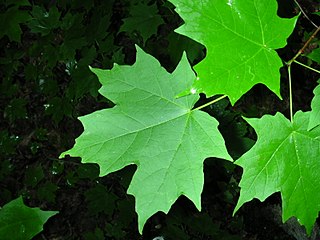
Acer saccharum, the sugar maple, is a species of flowering plant in the soapberry and lychee family Sapindaceae. It is native to the hardwood forests of eastern Canada and eastern United States. Sugar maple is best known for being the primary source of maple syrup and for its brightly colored fall foliage. It may also be called "rock maple," "sugar tree," "sweet maple," or, particularly in reference to the wood, "hard maple," "birds-eye maple," or "curly maple," the last two being specially figured lumber.
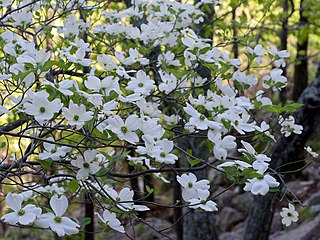
Cornus florida, the flowering dogwood, is a species of flowering tree in the family Cornaceae native to eastern North America and northern Mexico. An endemic population once spanned from southernmost coastal Maine south to northern Florida and west to the Mississippi River. The tree is commonly planted as an ornamental in residential and public areas because of its showy bracts and interesting bark structure.

Poa pratensis, commonly known as Kentucky bluegrass, smooth meadow-grass, or common meadow-grass, is a perennial species of grass native to practically all of Europe, North Asia and the mountains of Algeria and Morocco. It is a common and incredibly popular lawn grass in North America with the species being spread over all of the cool, humid parts of the United States, despite the fact that it is not native to North America. The Spanish Empire brought the seeds of Kentucky bluegrass to the New World in mixtures with other grasses. In its native range, Poa pratensis forms a valuable pasture plant, characteristic of well-drained, fertile soil. It is also used for making lawns in parks and gardens and has established itself as a common invasive weed across cool moist temperate climates like the Pacific Northwest and the Northeastern United States. When found on native grasslands in Canada, for example, it is considered an unwelcome exotic plant, and is indicative of a disturbed and degraded landscape.

Eriocoma hymenoides is a cool-season, perennial bunchgrass. It is native to western North America.
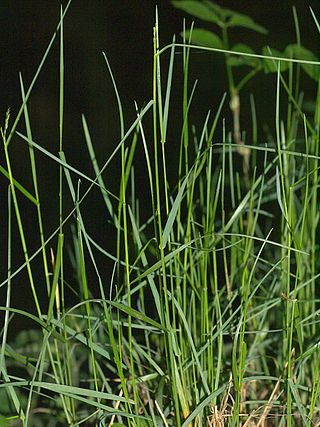
Poa nemoralis, the wood bluegrass, is a perennial plant in the family Poaceae. The late-growing grass is fairly nutritious for livestock, which feed on it in the autumn, and it is used as a lawn grass for shady situations.

Poa trivialis, is a perennial plant regarded in the US as an ornamental plant. It is part of the grass family.

Bromus madritensis is a species of brome grass known by the common name compact brome. The specific epithet madritensis refers to Madrid, Spain. It has a diploid number of 28.

Diarrhena americana, also known as American beak grass or American beakgrain, is a native, perennial bunchgrass of North America.

Solidago rugosa, commonly called the wrinkleleaf goldenrod or rough-stemmed goldenrod, is a species of flowering plant in the family Asteraceae. It is native to North America, where it is widespread across eastern and central Canada and the eastern and central United States. It is usually found in wet to mesic habitats.

Poa douglasii is a species of grass known by the common names Douglas' bluegrass and sand dune bluegrass. It is endemic to the coastline of California, where it grows in shifting sand dunes. It can be found mostly along the Central Coast and Channel Islands, and occasionally on the North Coast north of Mendocino. It is a perennial grass growing small, dense clumps up to about 30 centimeters in maximum height. It grows from a network of long rhizomes and stolons that anchor the grass to its loose sandy substrate; this network may be up to one meter long. The inflorescence is a dense, oval-shaped series of overlapping spikelets. The grass is dioecious, with male and female individuals producing different types of flowers in their inflorescences. This species, like many sand-dune endemic plants, is threatened by invasive species.

Poa leptocoma is a species of grass known by the common names marsh bluegrass and western bog bluegrass.

Poa macrantha is a species of grass known by the common names seashore bluegrass and large-flowered sand dune bluegrass. It is native to the west coast of North America from Alaska to northern California, where it grows in sand dunes and other beach habitat.
Puccinellia parishii is an uncommon species of grass known by the common names bog alkaligrass and Parish's alkali grass. It is native to the western United States, where it is known from a few locations in Arizona and New Mexico, and one occurrence each in California and Colorado.
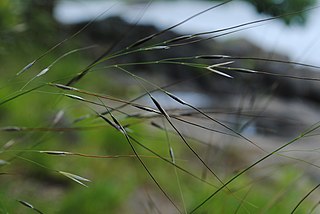
Piptochaetium avenaceum, commonly called black oat grass, blackseed needle grass or blackseed speargrass, is a species of perennial bunchgrass native to eastern North America. It is a member of the grass family Poaceae.
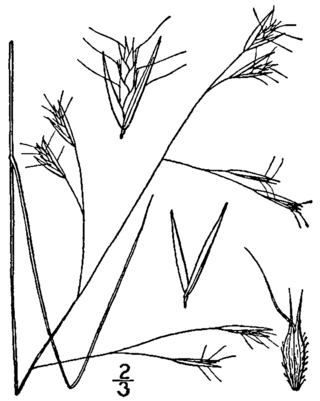
Danthonia compressa is a species of grass known by the common names mountain oatgrass, flattened oatgrass, and slender oatgrass.

Poa paludigena is a species of grass known by the common names bog bluegrass, marsh bluegrass, slender marsh bluegrass, and Patterson's bluegrass. It is native to the northeastern United States.

Poa fendleriana is a species of grass known by the common name muttongrass. It is native to western North America, where its distribution extends from western Canada to northern Mexico.

Arundinaria tecta, or switchcane, is a bamboo species native to the Southeast United States, first studied in 1813. It serves as host to several butterfly species. The species typically occurs in palustrine wetlands, swamps, small to medium blackwater rivers, on deep peat in pocosins, and in small seepages with organic soils. The species is only known to occur in the Atlantic Plain, Gulf Coastal Plain, and Mississippi Embayment, though it was earlier thought to exist in the Piedmont and Southern Appalachians as well. Specimens from the uplands are now thought to be a separate but morphologically similar species, Arundinaria appalachiana.
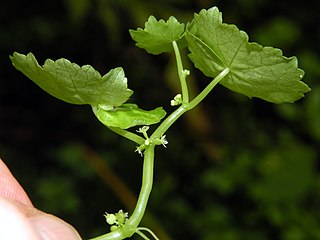
Hydrocotyle americana is a small plant native to the Northeastern United States. It is commonly referred to as American marshpennywort or navelwort and American water-pennywort. H. americana grows from Ontario to Newfoundland south through the Appalachian mountains to South Carolina. H. americana has been introduced to South Africa as well as New Zealand.
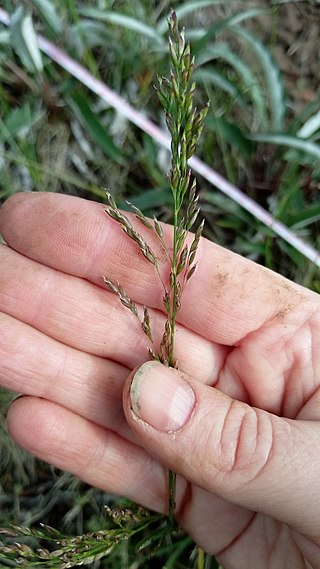
Poa alpigena is a species of grass occurring in mountainous regions. Its specific epithet "alpigena" means "growing in the alpine".



















